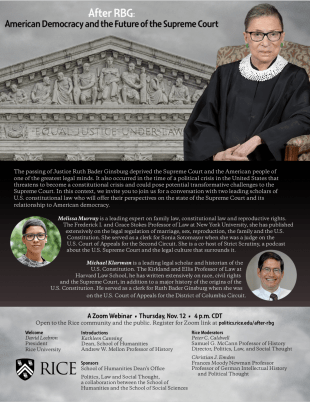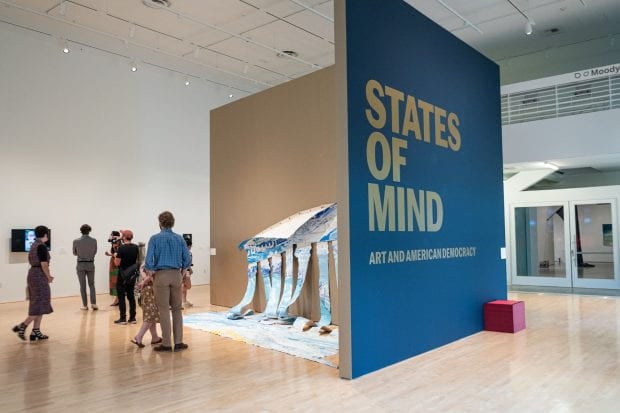Last month, President Donald Trump refused to commit to a peaceful transfer of power should he lose the upcoming election. Later that day, Trump told reporters at a press conference that the outcome of the election may “end up in the Supreme Court. And I think it’s very important that we have nine justices,” insinuating that his nominee to replace the late Ruth Bader Ginsburg would be the deciding vote.
What comes after Ginsburg? Should the aging institution continue to go unreformed? And is there a constitutional crisis on the horizon if Trump questions the outcome and legitimacy of the election?
Major challenges now facing the Supreme Court will be the topic of a Nov. 12 webinar sponsored by the Rice School of Humanities Dean’s Office and the Program in Politics, Law and Social Thought (PLST), a program shared by the schools of Humanities and Social Sciences.
“After RBG: American Democracy and the Future of the Supreme Court” is open to the public and will bring two leading professors of constitutional law together with moderators Peter C. Caldwell, the Samuel G. McCann Professor of History and PLST director, and Christian J. Emden, the Frances Moody Newman Professor of German Intellectual History and Political Thought and chair of the Department of Modern and Classical Literatures and Cultures.
New York University School of Law professor Melissa Murray and Harvard Law School professor Michael Klarman will draw on their extensive experience during a conversation designed to help understand the constitutional implications of the current political crisis.
“Both served as clerks for Supreme Court justices earlier in their careers: Professor Murray for Judge Sonia Sotomayor and Professor Klarman for Judge Ruth Bader Ginsburg,” Caldwell said. “Both are astute observers of the politics and history of the Supreme Court, and frequent commentators on the politics of the Supreme Court.”
Murray's work includes forays into the complex legal world of abortion rights, family law and the relationship between people's private lives and the law — issues at the center of current political debates, and likely to be affected by the new court. She is also a co-host of "Strict Scrutiny," a podcast about the U.S. Supreme Court and the legal culture that surrounds it. Klarman, in addition to publishing a recent book on the formation of the Constitution, has written extensively on civil rights law and is known as a leading constitutional historian. Both have authored lead articles in the forthcoming special issue on the Supreme Court for the “Harvard Law Review.”
Whatever the outcome of the election, there is a high likelihood the Supreme Court will be involved. And now that Justice Amy Coney Barrett, Trump’s conservative pick to replace Ginsburg, has been sworn in, those nine justices — and the institution they represent — could be placed in an impossible position come Nov. 4.
“It’s a sort of Catch-22 position for the Court, in that whatever they decide, it will lead to political discord and confusion,” Emden said. “And there will be a sufficiently large group of voters and politicians that will openly doubt the legitimacy of government. That is a fundamental problem of such a highly politicized court. And it is a serious problem for any democracy.”
All high courts have a legal-political balance, but the more political their decisions, the less legitimacy they retain as judicial bodies and the more the judges' appointments become a political issue.
“The Supreme Court here in the U.S. is like an ancient institution in many ways,” Caldwell said. “It's never been subjected to any serious reform.”
And yet the institution faces an increasingly complex array of issues at the very heart of American democracy and society: who is able to vote, how those people vote, who creates voting districts and why and what the limits of presidential power should be — indeed, what happens if a president refuses to accept the outcome of a vote.
“At issue is the damage to the legitimacy of the entire U.S. constitutional system has already sustained in the leadup to this election,” Caldwell said. “And at issue as well is the as-yet-unknown role of the Supreme Court following the election, whose composition has now dramatically changed as the result of the last three appointments.”
Even if the upcoming election results in a landslide victory for one candidate, these issues aren’t going anywhere.
“This event makes clear the significance of a program like Politics, Law and Social Thought that invites students to consider the law in its historical, social and political context,” said Dean of Humanities Kathleen Canning. “This undertaking is particularly important at a moment in time when not only the selection of Supreme Court justices, but the rule of law itself, has become deeply politicized.”
“The main goal of this event is to invite two notable legal scholars, both of who have worked closely with members of the Supreme Court, to explain the legal and political ramifications of the current crisis,” Caldwell said.
Rice President David Leebron will welcome Murray and Klarman to the Nov. 12 webinar and Dean Canning will introduce them beginning at 4 p.m. To register and submit questions in advance, visit politics.rice.edu/after-rbg.



